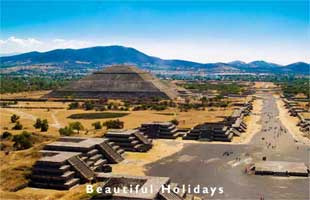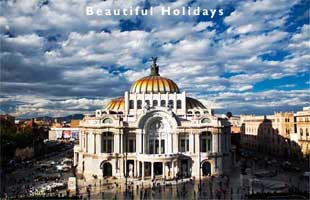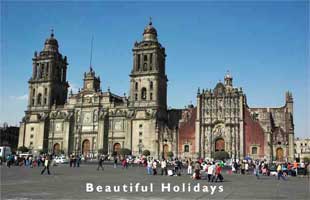Mexico City Hotels & Holidays
Mexico, Central America

Mexico City is huge but not a place many international travellers thinkt to visit. Situated inland, the third-largest city in the world has a bad reputaion for crime whic put-off many people from visiting although there are some wonderful places to explore. From the Centro Historico with its narrow cobblestoned streets to the Zona Rosa, the heart of the city's business and entertainment district, and the Templo Mayor, a thirteenth century archaelogical site, Mexico City is best suited to the more intrepid traveller.

Map of Mexico City

Teotihuacan - Ancient Mexico City
Mexico City Holidays Planner
Mexico City has a long history, pre-dating the arrival of Spanish explorer Hernan Cortes in 1519 when he discovered this Aztec city of Tenochtitlan and took it over from its Aztec Emperor Montezuma and re-named it Mexico City. Today, the heart of Mexico City, the zocalo rests on the site where Montezuma's palace once stood.
The Centro Historico, centred around the Plaza de la Constitucion is full of street vendors. Here you will find the zocalo, the original foundations of the city. When electrical workers discovered a carved stone relic when doing some routine excavations in 1978, there followed archaeological diggings that discovered first the Aztec temple of Tenochtitlan which was destroyed by conquistadors in 1521, but then further explorations revealed underneath there were the remains of six smaller and older temples that pre-dated the Aztec temple. You can visit this outdoor museum today on the zocalo at the Museo del Templo Mayor.
At one end of the zocalo you will find the Metropolitan Cathedral, the largest cathedral of the Americas. Construction began in 1573 and wasn't completed for another 300 years. The side chapels offer visitors a chance to make offerings to patron saints. The National Palace is also in the zocalo, begun in 1693, and was once the home of the Viceroy of New Spain, today murals by Diego Rivera grace its walls.
Also in the Centro Historico, you can visit some rather unusual museums. There is the Beer Museum, opened by Corona, which depicts the history of this beverage. Also in the area, you may stumble upon the Museo del Calzado, the Shoe Museum which displays a large private collection of footwear dating back to the nineteenth century. On a more sober note, you may want to visit Memorial 68, a museum which explores the events of 1968 in the run-up to the Olympic games when student protestors were killed by police in Tlatelolco.
Near the centre of the city is a large urban park called Chapultepec, or 'grasshopper.' Here, there are lakes, a zoo, and the Castillo de Chapultepec, an 18th century plaza with beautiful grounds that served as home to the Mexican President until 1939, and now serves as the Museo Nacional de Historica. Also in the park is the National Museum of Anthropology, one of the most extensive museums of its kind in the world. One of the museum's prize exhibits is the Monkey Cup, polished to obsidian hardness by what must have been generations of owners.
In Xochimilco, you can take a trajineras, a kind of gondola through historic Aztec irrigation channels. Another point of interest is the Museo Casa Luis Barragan, the home of self-trained Mexican architect Luis Barragan who was influenced by European Modernism and guided by principles of promoting serenity when he designed his buildings.
Mexico City also has some fascinating Mesoamerican ruins. In the heart of the city is Templo Mayor, where you walk around the ruins and then learn about the history and see Aztec artefacts in a cute museum. The most spectacular ruins though is at Teotihuacan, 40km north of the city, a huge ancient city covering 8 sq. km and once having a population of 125,000 people.

